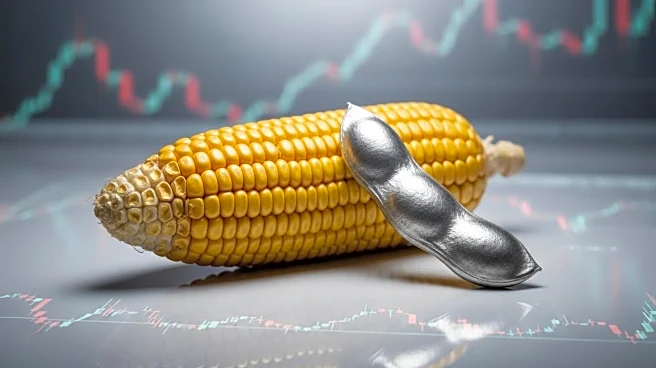What is the story about?
What's Happening?
The Commodity Futures Trading Commission (CFTC) has reported a significant shift in investor sentiment towards soybeans. In the week ending August 26, speculators turned bullish, holding a net-long position of 19,145 futures contracts in soybeans. This marks a reversal from a net-short position of 1,753 contracts the previous week, indicating the most optimistic outlook since June 24. Meanwhile, money managers reduced their net-short positions in corn futures to 110,935 contracts, the smallest since May 27. The CFTC's weekly Commitment of Traders report also highlighted changes in wheat futures, with a decrease in net-short positions for both hard-red and soft-red winter wheat. These shifts in futures positions reflect changing market expectations and investor strategies in response to current agricultural market conditions.
Why It's Important?
The shift towards a bullish stance on soybeans by speculators could have significant implications for the agricultural sector and related markets. A net-long position suggests that investors are anticipating higher prices, which could influence market dynamics and pricing strategies for farmers and traders. This change in sentiment may also impact the broader agricultural economy, affecting decisions on planting, harvesting, and sales. Additionally, the reduction in net-short positions for corn and wheat indicates a potential stabilization or increase in prices, which could benefit producers facing pressure from low commodity prices. These developments are crucial for stakeholders in the agricultural supply chain, including farmers, traders, and policymakers, as they navigate market volatility and economic pressures.
What's Next?
As trading resumes after the Labor Day holiday, market participants will closely monitor weather conditions and crop reports, which could further influence futures positions and pricing. The National Weather Service has forecasted potential storms in parts of North Dakota and Minnesota, which may affect crop yields and market expectations. Additionally, ongoing geopolitical and economic factors, such as trade policies and global demand, will continue to play a role in shaping market trends. Stakeholders will need to remain vigilant and adaptable to these evolving conditions to optimize their strategies and mitigate risks.
AI Generated Content
Do you find this article useful?

















